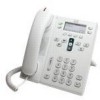Cisco 6941 Administration Guide - Page 133
Auxiliary Virtual Local Area Network VLAN con d on a Cisco Catalyst switch
 |
UPC - 882658277801
View all Cisco 6941 manuals
Add to My Manuals
Save this manual to your list of manuals |
Page 133 highlights
Chapter Network Setup Table 8-2 Network Setup Area Items (continued) Item Subnet Mask TFTP Server 1 TFTP Server 2 Default Router DNS Server Operational VLAN ID Admin. VLAN ID Unified CM 1 and 2 Information URL Directories URL Messages URL Services URL DHCP Enabled DHCP Address Released Alternate TFTP Idle URL Idle URL Time Proxy Server URL Description Subnet mask used by the phone. Primary Trivial File Transfer Protocol (TFTP) server used by the phone. Backup Trivial File Transfer Protocol (TFTP) server used by the phone. Default router used by the phone. Primary Domain Name System (DNS) server (DNS Server 1) and optional backup DNS servers (DNS Server 2-5) used by the phone. Auxiliary Virtual Local Area Network (VLAN) configured on a Cisco Catalyst switch in which the phone is a member. Auxiliary VLAN in which the phone is a member. Host names or IP addresses, in prioritized order, of the Cisco Unified Communications Manager servers with which the phone can register. An item can also show the IP address of an SRST router that is capable of providing limited Cisco Unified Communications Manager functionality, if such a router is available. For an available server, an item will show the Cisco Unified Communications Manager server IP address and one of the following states: • Active-Cisco Unified Communications Manager server from which the phone is currently receiving call-processing services. • Standby-Cisco Unified Communications Manager server to which the phone switches if the current server becomes unavailable. • Blank-No current connection to this Cisco Unified Communications Manager server. An item may also include the Survivable Remote Site Telephony (SRST) designation, which identifies an SRST router capable of providing Cisco Unified Communications Manager functionality with a limited feature set. This router assumes control of call processing if all other Cisco Unified Communications Manager servers become unreachable. The SRST Cisco Unified Communications Manager always appears last in the list of servers, even if it is active. You configure the SRST router address in the Device Pool section in Cisco Unified Communications Manager Configuration window. URL of the help text that appears on the phone. URL of the server from which the phone obtains directory information. URL of the server from which the phone obtains message services. URL of the server from which the phone obtains Cisco Unified IP Phone services. Indicates whether DHCP is being used by the phone. Indicates the setting of the DHCP Address Released option on the phone's Network Setup menu. Indicates whether the phone is using an alternative TFTP server. URL that the phone displays when the phone has not been used for the time specified by Idle URL Time, and no menu is open. Number of seconds that the phone has not been used and no menu is open before the XML service specified by Idle URL is activated. URL of proxy server, which makes HTTP requests to non-local host addresses on behalf of the phone HTTP client and provides responses from the non-local host to the phone HTTP client. Cisco Unified IP Phone 6921, 6941, 6945, and 6961 Administration Guide for Cisco Unified Communications Manager 8.5 (SCCP and SIP) OL-23769-01 8-5















